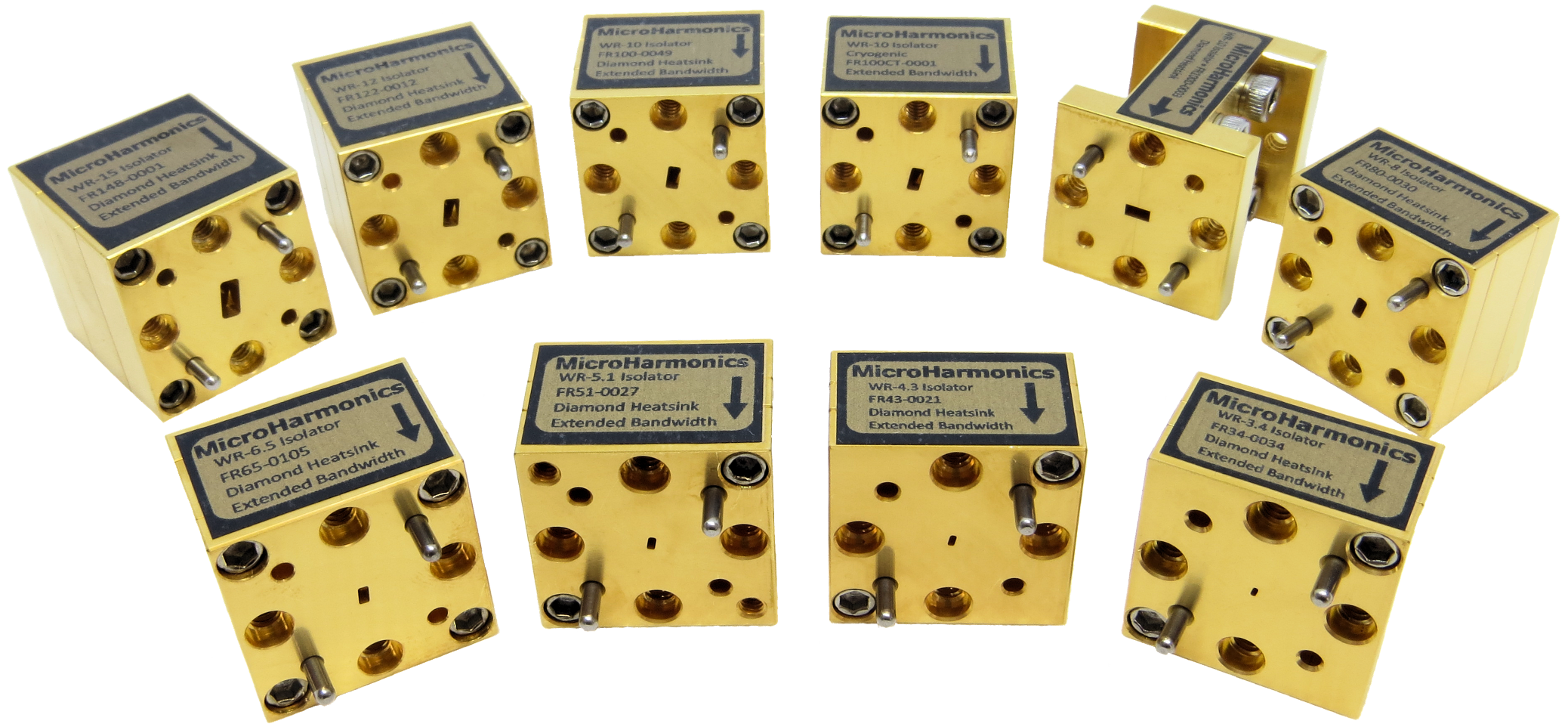By Dr. Dave Rizzo, US-based technology writer
It doesn’t take much guessing to know where the future of wireless is heading. With 5G, 6G and beyond, ultra-high definition video, autonomous driving cars, security applications and IoT, the sky’s the limit for harnessing the higher ends of the electromagnetic (EM) spectrum, frequencies between 30GHz and 500GHz, or the millimeter wave (MMW) bands.
Yet, these higher frequencies present a significant problem that design engineers must address – standing waves. Without control, these unwanted waves can attenuate power output, distort the carrier’s information and, in extreme cases, even damage internal components.

Harnessing isolators
To counteract the problem of standing waves at lower microwave frequencies, engineers rely on Faraday rotation isolators, more commonly referred to as simply isolators. At its very basic level, an isolator is a two-port, input and output, component that allows EM signals to pass in one direction but absorbs them in the opposite. However, traditional isolators fall short at the higher frequencies required for next-generation wireless applications.
A big part of the problem is that the first isolators were designed over half a century ago, with very few modifications since. With recent advancements, however, companies at the cutting edge of MMW technologies are now launching products that operate optimally at stratospheric frequencies.
“The new series of waveguide isolators have been a key enabling technology and a large advance from what was previously available,” said Jeffrey Hesler, PhD, CTO of Virginia Diodes (VDI), manufacturer of state-of-the-art test and measurement equipment – such as vector network analyzer, spectrum analyzer and signal generator extension modules – for MMW and THz applications.
“The compact size, extremely low insertion loss, and the wide bandwidth have allowed us to use isolators in a wider variety of our systems than was previously possible, leading to significant improvements in key system performance metrics such as source power and sensitivity,” said Hesler.
By understanding these advancements in each of the five properties of isolator functionality, designers can better harness isolators to improve their MMW products:
1. High isolation
Isolation is a measure of how much of the signal travelling in the reverse direction passes back through the isolator. Because isolators are intended to prevent or minimise this from happening, the higher the isolation, the better.
“The issue that MMW system designers face is impedance mismatches and the resulting reflections between components,” said David Porterfield, Founder and CEO of Micro Harmonics Corporation (MHC), which specialises in design solutions for components used in MMW products.
Under a two-phased NASA contract awarded in 2015, the company successfully developed an advanced line of isolators for WR-15 through WR-3.4 (50-330GHz) applications.
“In MMW systems, the distance between components is often more than a wavelength, putting reflected signals out of phase, effectively perturbing the operating point of the upstream component,” said Porterfield. “As you sweep frequencies, the phase changes and you get nulls, dips and degraded performance. However, when you insert an isolator between components, the reflected signal gets absorbed and the problem goes away.”

The highest possible isolation occurs when the reverse wave is rotated exactly 45° into the plane of the isolator’s resistive layer. Isolation can degrade by as much as 10dB when the signal rotation is off by just 1°.
“The only way to confirm such precision is to fully characterise each isolator on a vector network analyser,” said Porterfield. “This validates total compliance, as opposed to just spot-checking at a couple of frequencies in the band.”
2. Low insertion loss
Whilst isolation is the namesake of these components, the suppression of the reverse wave can’t come at the expense of attenuating the forward, input signal. Insertion loss is a measure of how much loss a signal incurs as it passes through the isolator in the forward direction. For traditional-style isolators, insertion loss is low in the microwave bands, but at MMW frequencies the loss becomes increasingly problematic. For instance, in the WR-10 band (75-110GHz) the insertion loss can exceed 3dB, meaning half of the signal power is lost. In the WR-5.1 band (140-220GHz) the loss climbs to over 5dB. Because of high losses, traditional isolators are often precluded from use in MMW systems.
“A designer’s main fear is that the isolator will significantly degrade the strength of the final output,” continued Porterfield. “It can be frustrating for engineers to try and tune the standing waves out of each system, usually with limited success. Many of the alternate methods used are narrow band in nature, so that the solution may work well only over an insufficiently narrow band of frequencies.”
Faraday rotation isolators operate by using ferrite discs to rotate the signal. However, the traditional method to manufacturer them has been to use ferrites that are substantially longer than the minimum required length, and then tune the magnetic bias field to achieve optimal performance. This delivers good isolation, but at a much higher insertion loss.
Porterfield points out a two-fold problem with this workaround. First, there is more of the lossy ferrite in the signal path and, second, the ferrite loss parameter increases at lower magnetisation levels.
To minimise loss, it is essential that the ferrite length is reduced as much as possible. The design developed for NASA saturates the ferrite with a strong magnetic bias field, which allows for the shortest possible length of ferrite to achieve the ideal 45° rotation. This lowers the insertion loss to less than 1dB at 75-110GHz and only 2dB at 220-330GHz.
“The extension of isolator technology above 220GHz is an impressive technical feat and a key technology that enables us to deliver accurate measurements with higher sensitivity than we were previously able to achieve,” said VDI’s Hesler.
3. Low port reflection
A good isolator must also have low port reflections. Voltage Standing Wave Ratio (VSWR) is a measure of reflections at the input and output ports. A good range at MMW frequencies is 1.5:1 or less, whereas 1:1 equals no reflection.
The importance of low port reflections is often overlooked. An isolator with high port reflections creates an alternate set of standing waves. The adjacent components are still adversely impacted by out-of-phase signals reflected back into their ports. High isolation and low insertion loss are of little value if the port reflections are large.
4. High power rating
Power in the reverse travelling signal is absorbed in the isolator, resulting in heat. The more heat it can handle, the higher the power rating. Historically, high heat was not an issue as there was very little power available at MMW frequencies. However, as higher power sources become available, the importance of power ratings increases.
To handle high heat loads, some newer isolators are already incorporating diamond heat sinks into their designs. Diamond is the ultimate thermal conductor, approaching 2200W/mK, more than five times higher than copper. Diamond effectively channels heat from the resistive layer in the isolator to the metal waveguide block and, thus, lowers operating temperatures for improved reliability.

5. Small footprint
Minimising the size and weight of MMW components is especially important in today’s wireless applications.
“A standard traditional-style isolator in the WR10 band is about three inches long, with a cylindrical section in the centre that’s about 1.3 inches in diameter,” said Porterfield. “But the newest design shapes are rectangular and can be as small as 0.75 inches per side and 0.45 inches thick.”
The same technology used to reduce insertion loss – utilising the shortest possible length of ferrite – also partially accounts for the reduction in footprint.
Other properties
In addition to the five critical characteristics, other properties of modern isolators improve their utility at MMW frequencies, such as wide bandwidth, for example. Standard waveguide bands typically extend to 40% on either side of the centre frequency. Newer, high-performing isolators operate over extended bandwidths exceeding 50% from centre frequency, giving designers greater freedom to build more bandwidth into their systems.
Additional advances include isolators that operate in cryogenic conditions, which is critical because a traditional isolator designed for room-temperature operation will perform poorly when cooled.









